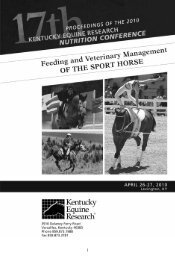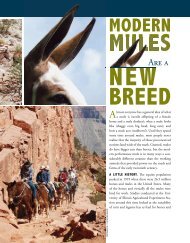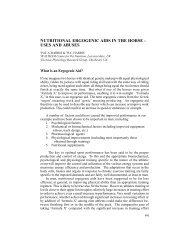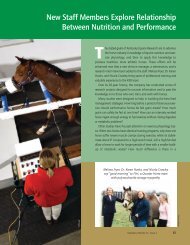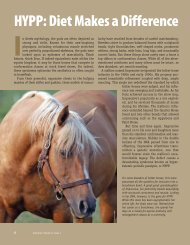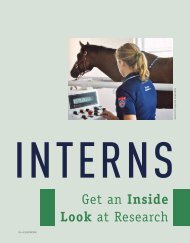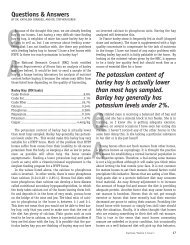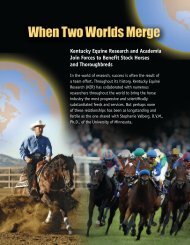Understanding Digestion in the Horse, A Comparative Approach
Understanding Digestion in the Horse, A Comparative Approach
Understanding Digestion in the Horse, A Comparative Approach
You also want an ePaper? Increase the reach of your titles
YUMPU automatically turns print PDFs into web optimized ePapers that Google loves.
extremely high <strong>in</strong>take and short retention time. Although <strong>the</strong><br />
panda’s diet of bamboo is high <strong>in</strong> fiber, digestibility of fiber is<br />
quite low. Instead, pandas extract <strong>the</strong> cell contents from <strong>the</strong><br />
bamboo, and <strong>the</strong> animals depend very little on microbial fermentation.<br />
Prote<strong>in</strong> digestibility was 90% from <strong>the</strong> bamboo<br />
because most of <strong>the</strong> prote<strong>in</strong> <strong>in</strong> bamboo is located with<strong>in</strong> <strong>the</strong> cell<br />
contents ra<strong>the</strong>r than <strong>in</strong> <strong>the</strong> cell wall.<br />
<strong>Horse</strong>s and elephants illustrate <strong>the</strong> general trend <strong>in</strong> rate of<br />
passage and digestibility <strong>in</strong> large nonrum<strong>in</strong>ant herbivores as it<br />
relates to body size. <strong>Horse</strong>s have a rate of passage equal to about<br />
30 hours, and <strong>the</strong>y digest about 50% of <strong>the</strong> dry matter <strong>in</strong> hay.<br />
Elephants, conversely, have a shorter retention time, about 24<br />
hours, and lower dry matter digestibility. Fiber and prote<strong>in</strong><br />
digestibilities follow <strong>the</strong> same trend.<br />
Microbial populations <strong>in</strong> different species. Although animals<br />
vary greatly <strong>in</strong> <strong>the</strong>ir dependence on microbial fermentation, <strong>the</strong><br />
populations of microbes that <strong>in</strong>habit <strong>the</strong> organs utilized for fermentation<br />
and <strong>the</strong> environments with<strong>in</strong> <strong>the</strong>se organs are<br />
remarkably similar.<br />
Despite <strong>the</strong> fact that pigs, dogs, and ponies vary tremendously<br />
<strong>in</strong> <strong>the</strong>ir dependence on microbial digestion, <strong>the</strong>y all have h<strong>in</strong>dgut<br />
environments conducive to fermentation. While VFA concentrations<br />
are high <strong>in</strong> <strong>the</strong> large <strong>in</strong>test<strong>in</strong>e of each of <strong>the</strong>se species, pigs<br />
and dogs have higher colonic VFA concentrations than ponies.<br />
This shows that species that are normally thought of as monogastrics<br />
have active sites of fermentation <strong>in</strong> <strong>the</strong>ir large <strong>in</strong>test<strong>in</strong>es.<br />
Pigs are quite capable of utiliz<strong>in</strong>g high-fiber diets, though<br />
this fact has been largely ignored as <strong>in</strong>tensive sw<strong>in</strong>e management<br />
programs have developed. These days, pigs are often<br />
kept <strong>in</strong> conf<strong>in</strong>ement and fed high-starch diets that conta<strong>in</strong> significant<br />
amounts of corn. In <strong>the</strong>ir classic animal husbandry<br />
text, Feeds and Feed<strong>in</strong>g (N<strong>in</strong>eteenth Edition), Henry and<br />
Morrison state, “Pastures are so important to pork production<br />
that <strong>the</strong>y often make all <strong>the</strong> difference between profit and<br />
loss. Few facts <strong>in</strong> sw<strong>in</strong>e feed<strong>in</strong>g have been so clearly proven,<br />
both by scientific experiments and <strong>in</strong> <strong>the</strong> common experience<br />
of successful farmers, as <strong>the</strong> high value of pasture or forage<br />
crops for all classes of sw<strong>in</strong>e.”<br />
In horses <strong>the</strong> microflora <strong>in</strong> <strong>the</strong> h<strong>in</strong>dgut are susceptible to diets<br />
that veer severely from primarily forage. A close look at starch,<br />
which is abundant <strong>in</strong> cereal gra<strong>in</strong>s such as corn, barley, and oats,<br />
proves that it is a versatile energy source. However, problems arise<br />
when it is overfed. Studies at Kentucky Equ<strong>in</strong>e Research (KER)<br />
have shown that pH of <strong>the</strong> h<strong>in</strong>dgut drops significantly <strong>in</strong> horses<br />
follow<strong>in</strong>g a gra<strong>in</strong> meal rich <strong>in</strong> starch, with <strong>the</strong> lowest po<strong>in</strong>t occurr<strong>in</strong>g<br />
between four and eight hours after feed<strong>in</strong>g. Changes <strong>in</strong><br />
h<strong>in</strong>dgut pH make horses susceptible to colic and lam<strong>in</strong>itis. For<br />
this reason and o<strong>the</strong>rs, KER nutritionists generally recommend<br />
gra<strong>in</strong> meals be small, generally not exceed<strong>in</strong>g five pounds.<br />
For horses that must consume large quantities of gra<strong>in</strong> <strong>in</strong> order<br />
to fuel exercise or ma<strong>in</strong>ta<strong>in</strong> body weight, a h<strong>in</strong>dgut buffer such as<br />
KER’s EquiShure is appropriate because it steadies <strong>the</strong> pH, prevent<strong>in</strong>g<br />
sudden downward shifts that could harm microflora.<br />
Interspecies Comparisons<br />
A constant source of debate among animal nutritionists is<br />
whe<strong>the</strong>r <strong>in</strong>formation from one species can be used to improve <strong>the</strong><br />
way o<strong>the</strong>r species are fed. Are data ga<strong>the</strong>red from rum<strong>in</strong>ants relevant<br />
to horses? Are data ga<strong>the</strong>red from horses transferable to<br />
pigs? In light of <strong>the</strong> similarities between microbial fermentation<br />
across many species, <strong>the</strong> answer would appear to be yes.<br />
One example of this <strong>in</strong>volves yeast culture. Early work with<br />
rum<strong>in</strong>ants showed that yeast culture affected microbial fermentation<br />
<strong>in</strong> a number of beneficial ways. Initially, nonrum<strong>in</strong>ant<br />
nutritionists dismissed this <strong>in</strong>formation as unimportant for monogastric<br />
animals primarily because <strong>the</strong> rumen was deemed an<br />
<strong>in</strong>appropriate model for rabbits, pigs, or horses. Research with<br />
rabbits and horses, <strong>in</strong>clud<strong>in</strong>g some conducted at KER, showed<br />
that yeast culture affects <strong>the</strong> <strong>in</strong>test<strong>in</strong>al microbes <strong>in</strong> <strong>the</strong>se species<br />
<strong>in</strong> much <strong>the</strong> same way that rumen microflora are affected.<br />
Transfer of <strong>in</strong>formation across species is important for <strong>the</strong> wellbe<strong>in</strong>g<br />
of all animals. An open-m<strong>in</strong>ded approach to feed<strong>in</strong>g often<br />
yields benefits for multiple species.<br />
Microbial fermentation is important for most animals. The<br />
anatomical adaptations that each species has developed depend<br />
primarily on body size and natural diet. The total volume of <strong>the</strong><br />
digestive tract devoted to fermentation and <strong>the</strong> amount of time<br />
digesta spends <strong>in</strong> <strong>the</strong>se organs varies greatly from species to<br />
species. The types of microflora that <strong>in</strong>habit <strong>the</strong> digestive tracts of<br />
various animals, however, are similar. Thus, it would seem logical<br />
that dietary manipulations that affect one species may also<br />
affect o<strong>the</strong>r species if <strong>the</strong> differences that exist between <strong>in</strong>test<strong>in</strong>al<br />
architecture are taken <strong>in</strong>to account.<br />
When research<strong>in</strong>g feeds and feed<strong>in</strong>g practices for horses,<br />
KER nutritionists look beyond research conducted on horses. By<br />
cast<strong>in</strong>g a wider net and look<strong>in</strong>g at <strong>the</strong> research performed <strong>in</strong><br />
o<strong>the</strong>r species, KER feed formulators ma<strong>in</strong>ta<strong>in</strong> <strong>the</strong>ir scientific<br />
advantage.<br />
Equ<strong>in</strong>ews/Volume 10, Issue 3 9



